Abstract
A linear correlation coefficient analysis, comparing in vivo anti-infective and reticuloendothelial stimulating activity of several different analogs of N-acetylmuramyl-L-alanyl-D-isoglutamine (muramyl dipeptide) suggests that the macrophage is an important target cell for these immunomodulating compounds. The increase in protection against infections of Candida albicans or Pseudomonas aeruginosa in normal or immunosuppressed mice after treatment with 18 different glycopeptides was found to correlate with the degree of clearance of colloidal carbon particles from the blood by the reticuloendothelial system after treatment with the same muramyl dipeptide analogs. The compound which gave the greatest protection in all four assays was N-acetylmuramyl-L-alpha-aminobutyryl-D-isoglutamine followed by N-acetyl-nor-muramyl-L-alanyl-D-isoglutamine. Both analogs were better than the parent muramyl dipeptide. Whether macrophage stimulation alone is responsible for the anti-infective properties of these compounds has not yet been determined.
Full text
PDF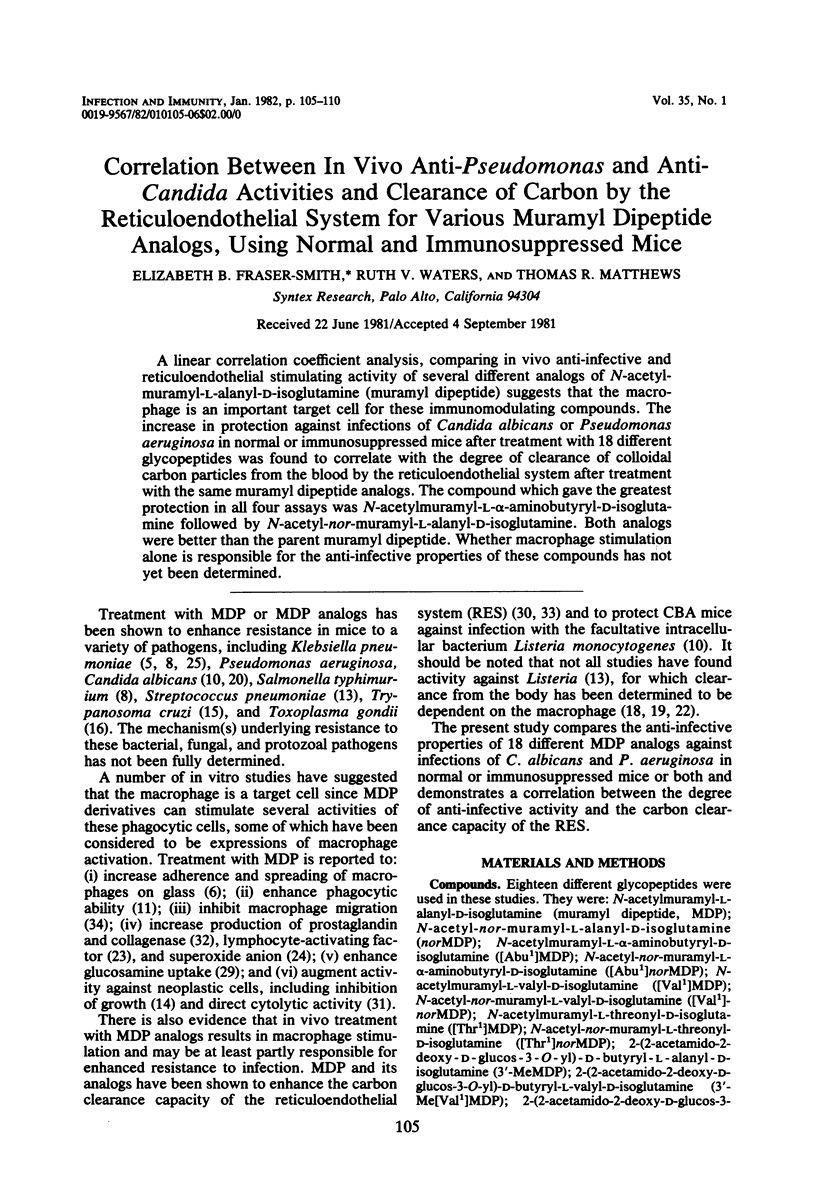
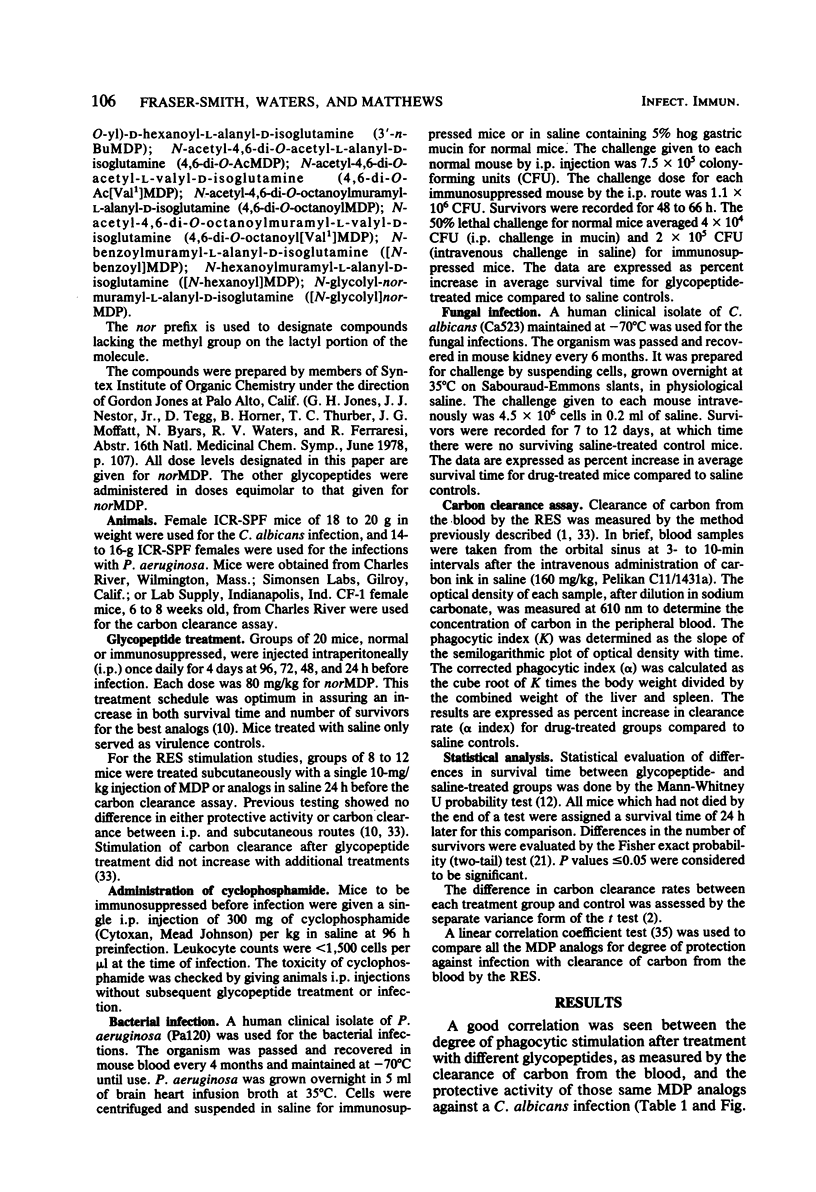
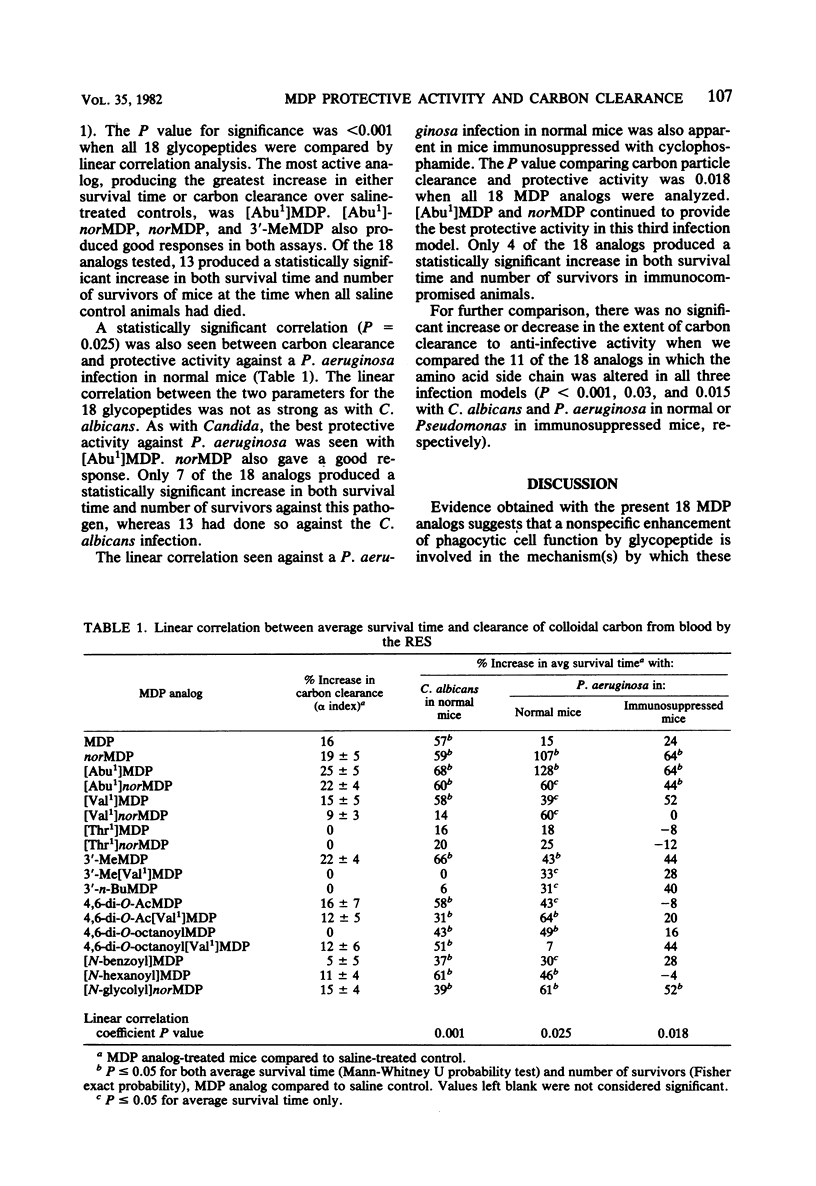
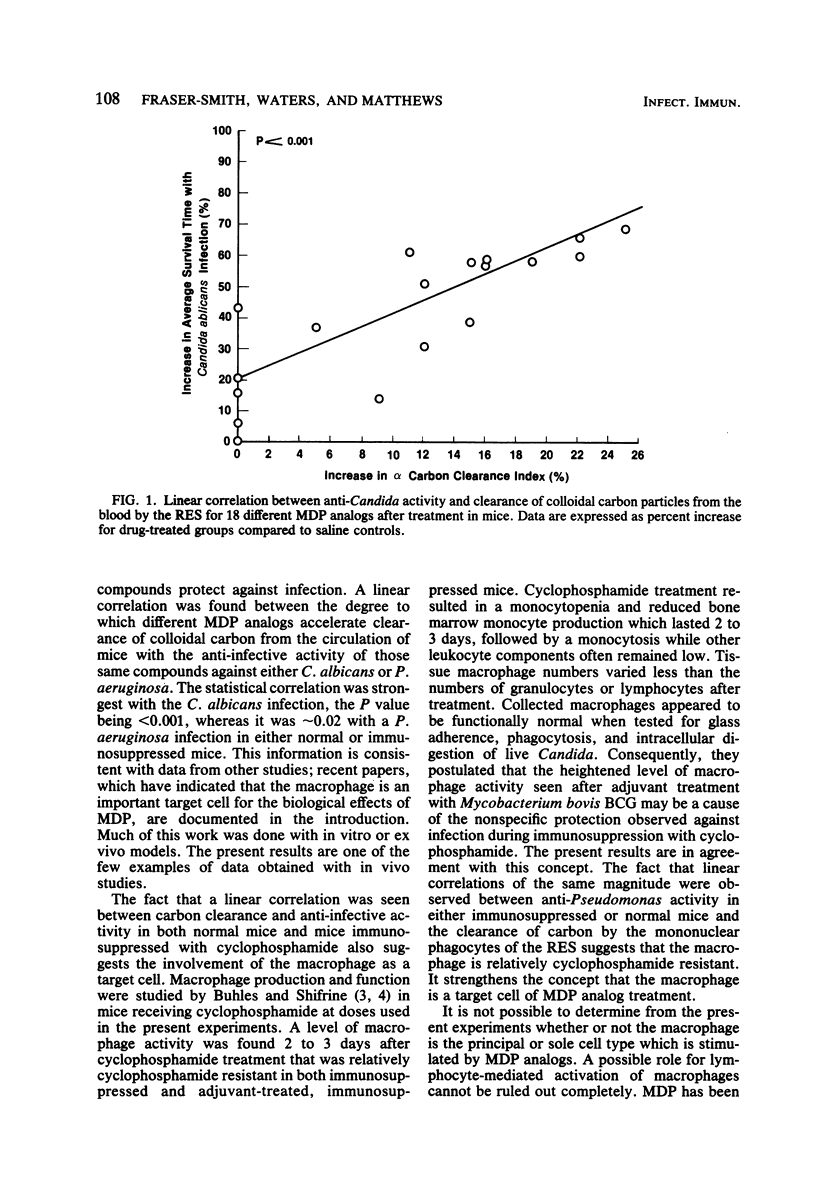
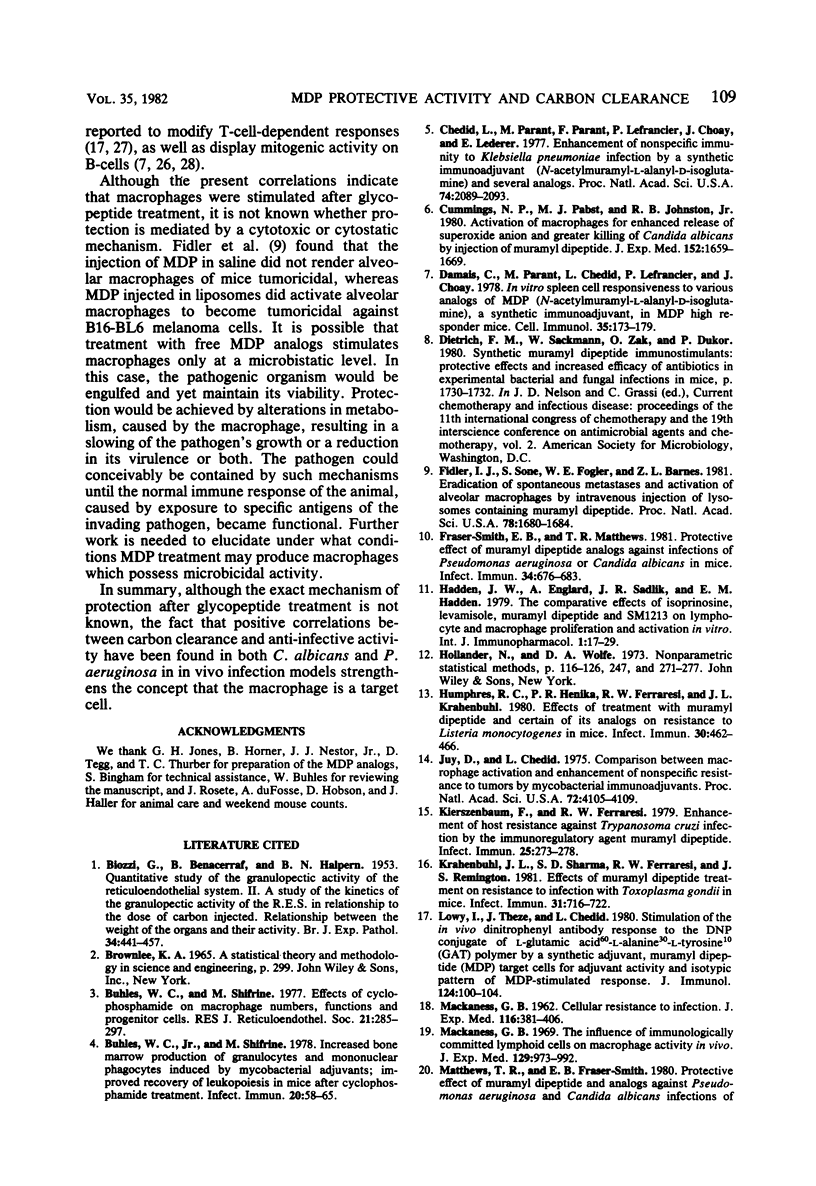
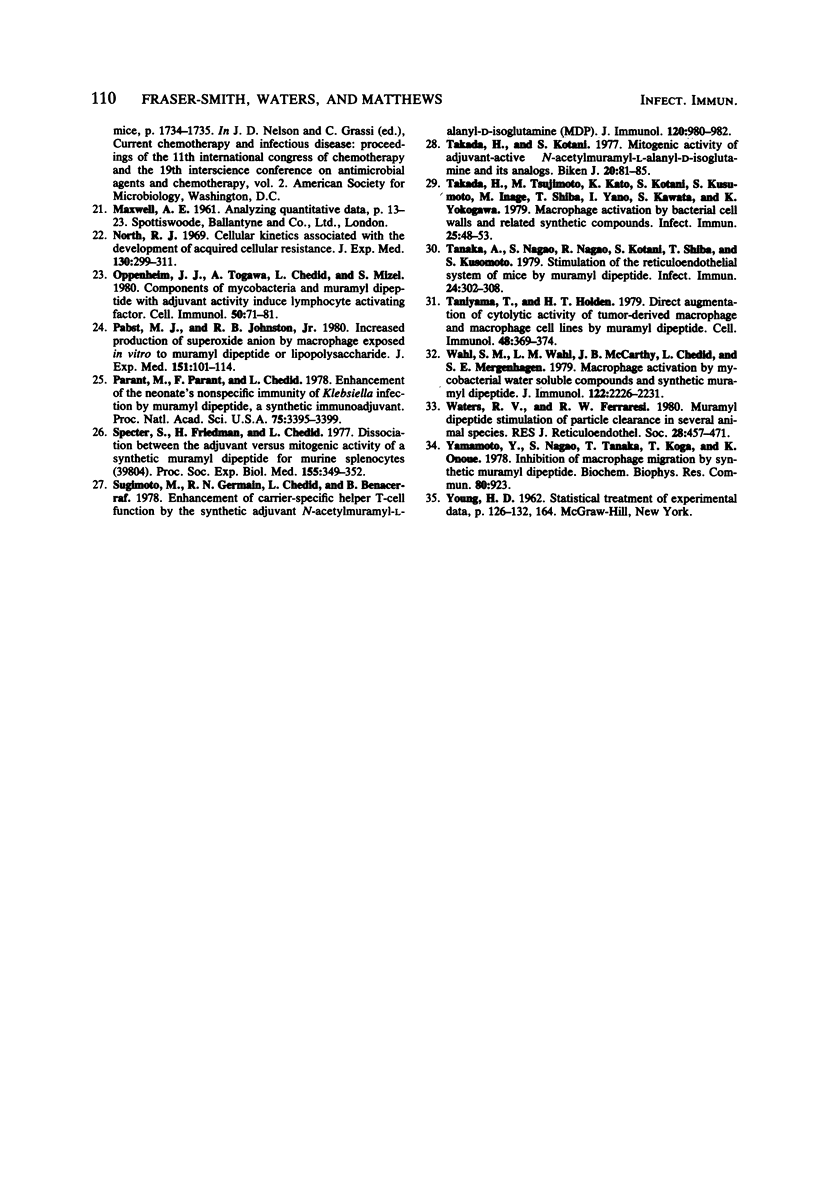
Selected References
These references are in PubMed. This may not be the complete list of references from this article.
- BIOZZI G., BENACERRAF B., HALPERN B. N. Quantitative study of the granulopectic activity of the reticulo-endothelial system. II. A study of the kinetics of the R. E. S. in relation to the dose of carbon injected; relationship between the weight of the organs and their activity. Br J Exp Pathol. 1953 Aug;34(4):441–457. [PMC free article] [PubMed] [Google Scholar]
- Buhles W. C., Jr, Shifrine M. Effects of cyclophosphamide on macrophage numbers, functions and progenitor cells. J Reticuloendothel Soc. 1977 May;21(5):285–297. [PubMed] [Google Scholar]
- Buhles W. C., Jr, Shifrine M. Increased bone marrow production of granulocytes and mononuclear phagocytes induced by mycobacterial adjuvants: improved recovery of leukopoiesis in mice after cyclophosphamide treatment. Infect Immun. 1978 Apr;20(1):58–65. doi: 10.1128/iai.20.1.58-65.1978. [DOI] [PMC free article] [PubMed] [Google Scholar]
- Chedid L., Parant M., Parant F., Lefrancher P., Choay J., Lederer E. Enhancement of nonspecific immunity to Klebsiella pneumoniae infection by a synthetic immunoadjuvant (N-acetylmuramyl-L-alanyl-D-isoglutamine) and several analogs. Proc Natl Acad Sci U S A. 1977 May;74(5):2089–2093. doi: 10.1073/pnas.74.5.2089. [DOI] [PMC free article] [PubMed] [Google Scholar]
- Cummings N. P., Pabst M. J., Johnston R. B., Jr Activation of macrophages for enhanced release of superoxide anion and greater killing of Candida albicans by injection of muramyl dipeptide. J Exp Med. 1980 Dec 1;152(6):1659–1669. doi: 10.1084/jem.152.6.1659. [DOI] [PMC free article] [PubMed] [Google Scholar]
- Damais C., Parant M., Chedid L., Lefrancier P., Choay J. In vitro spleen cell responsiveness to various analogs of MDP (N-acetylmuramyl-L-alanyl-D-isoglutamine), a synthetic immunoadjuvant, in MDP high-responder mice. Cell Immunol. 1978 Jan;35(1):173–179. doi: 10.1016/0008-8749(78)90137-5. [DOI] [PubMed] [Google Scholar]
- Fidler I. J., Sone S., Fogler W. E., Barnes Z. L. Eradication of spontaneous metastases and activation of alveolar macrophages by intravenous injection of liposomes containing muramyl dipeptide. Proc Natl Acad Sci U S A. 1981 Mar;78(3):1680–1684. doi: 10.1073/pnas.78.3.1680. [DOI] [PMC free article] [PubMed] [Google Scholar]
- Fraser-Smith E. B., Matthews T. R. Protective effect of muramyl dipeptide analogs against infections of Pseudomonas aeruginosa or Candida albicans in mice. Infect Immun. 1981 Dec;34(3):676–683. doi: 10.1128/iai.34.3.676-683.1981. [DOI] [PMC free article] [PubMed] [Google Scholar]
- Hadden J. W., Englard A., Sadlik J. R., Hadden E. M. The comparative effects of isoprinosine, levamisole, muramyl dipeptide and SM1213 on lymphocyte and macrophage proliferation and activation in vitro. Int J Immunopharmacol. 1979;1(1):17–27. doi: 10.1016/0192-0561(79)90026-2. [DOI] [PubMed] [Google Scholar]
- Humphres R. C., Henika P. R., Ferraresi R. W., Krahenbuhl J. L. Effects of treatment with muramyl dipeptide and certain of its analogs on resistance to Listeria monocytogenes in mice. Infect Immun. 1980 Nov;30(2):462–466. doi: 10.1128/iai.30.2.462-466.1980. [DOI] [PMC free article] [PubMed] [Google Scholar]
- Juy D., Chedid L. Comparison between macrophage activation and enhancement of nonspecific resistance to tumors by mycobacterial immunoadjuvants. Proc Natl Acad Sci U S A. 1975 Oct;72(10):4105–4109. doi: 10.1073/pnas.72.10.4105. [DOI] [PMC free article] [PubMed] [Google Scholar]
- Kireszenbaum F., Ferraresi R. W. Enhancement of host resistance against Trypanosoma cruzi infection by the immunoregulatory agent muramyl dipeptide. Infect Immun. 1979 Jul;25(1):273–278. doi: 10.1128/iai.25.1.273-278.1979. [DOI] [PMC free article] [PubMed] [Google Scholar]
- Krahenbuhl J. L., Sharma S. D., Ferraresi R. W., Remington J. S. Effects of muramyl dipeptide treatment on resistance to infection with Toxoplasma gondii in mice. Infect Immun. 1981 Feb;31(2):716–722. doi: 10.1128/iai.31.2.716-722.1981. [DOI] [PMC free article] [PubMed] [Google Scholar]
- Lowy I., Theze J., Chedid L. Stimulation of the in vivo dinitrophenyl antibody response to the DNP conjugate of L-glutamic acid60-L-alanine30-L-Tyrosine10 (GAT) polymer by a synthetic adjuvant, muramyl dipeptide (MDP): target cells for adjuvant activity and isotypic pattern of MDP-stimulated response. J Immunol. 1980 Jan;124(1):100–104. [PubMed] [Google Scholar]
- MACKANESS G. B. Cellular resistance to infection. J Exp Med. 1962 Sep 1;116:381–406. doi: 10.1084/jem.116.3.381. [DOI] [PMC free article] [PubMed] [Google Scholar]
- North R. J. Cellular kinetics associated with the development of acquired cellular resistance. J Exp Med. 1969 Aug 1;130(2):299–314. doi: 10.1084/jem.130.2.299. [DOI] [PMC free article] [PubMed] [Google Scholar]
- Oppenheim J. J., Togawa A., Chedid L., Mizel S. Components of mycobacteria and muramyl dipeptide with adjuvant activity induce lymphocyte activating factor. Cell Immunol. 1980 Mar 1;50(1):71–81. doi: 10.1016/0008-8749(80)90007-6. [DOI] [PubMed] [Google Scholar]
- Pabst M. J., Johnston R. B., Jr Increased production of superoxide anion by macrophages exposed in vitro to muramyl dipeptide or lipopolysaccharide. J Exp Med. 1980 Jan 1;151(1):101–114. doi: 10.1084/jem.151.1.101. [DOI] [PMC free article] [PubMed] [Google Scholar]
- Parant M., Parant F., Chedid L. Enhancement of the neonate's nonspecific immunity to Klebsiella infection by muramyl dipeptide, a synthetic immunoadjuvant. Proc Natl Acad Sci U S A. 1978 Jul;75(7):3395–3399. doi: 10.1073/pnas.75.7.3395. [DOI] [PMC free article] [PubMed] [Google Scholar]
- Specter S., Friedman H., Chedid L. Dissociation between the adjuvant vs mitogenic activity of a synthetic muramyl dipeptide for murine splenocytes. Proc Soc Exp Biol Med. 1977 Jul;155(3):349–352. doi: 10.3181/00379727-155-39804. [DOI] [PubMed] [Google Scholar]
- Sugimoto M., Germain R. N., Chedid L., Benacerraf B. Enhancement of carrier-specific helper T cell function by the synthetic adjuvant, N-acetyl muramyl-L-alanyl-D-isoglutamine (MDP). J Immunol. 1978 Mar;120(3):980–982. [PubMed] [Google Scholar]
- Takada H., Kotani S., Kusumoto S., Tarumi Y., Ikenaka K. Mitogenic activity of adjuvant-active N-acetylmuramyl-L-alanyl-D-isoglutamine and its analogues. Biken J. 1977 Jun;20(2):81–85. [PubMed] [Google Scholar]
- Takada H., Tsujimoto M., Kato K., Kotani S., Kusumoto S., Inage M., Shiba T., Yano I., Kawata S., Yokogawa K. Macrophage activation by bacterial cell walls and related synthetic compounds. Infect Immun. 1979 Jul;25(1):48–53. doi: 10.1128/iai.25.1.48-53.1979. [DOI] [PMC free article] [PubMed] [Google Scholar]
- Tanaka A., Nagao S., Nagao R., Kotani S., Shiba T., Kusumoto S. Stimulation of the reticuloendothelial system of mice by muramyl dipeptide. Infect Immun. 1979 May;24(2):302–307. doi: 10.1128/iai.24.2.302-307.1979. [DOI] [PMC free article] [PubMed] [Google Scholar]
- Taniyama T., Holden H. T. Direct augmentation of cytolytic activity of tumor-derived macrophages and macrophage cell lines by muramyl dipeptide. Cell Immunol. 1979 Dec;48(2):369–374. doi: 10.1016/0008-8749(79)90131-x. [DOI] [PubMed] [Google Scholar]
- Wahl S. M., Wahl L. M., McCarthy J. B., Chedid L., Mergenhagen S. E. Macrophage activation by mycobacterial water soluble compounds and synthetic muramyl dipeptide. J Immunol. 1979 Jun;122(6):2226–2231. [PubMed] [Google Scholar]
- Waters R. V., Ferraresi R. W. Muramyl dipeptide stimulation of particle clearance in several animal species. J Reticuloendothel Soc. 1980 Nov;28(5):457–471. [PubMed] [Google Scholar]
- Yamamoto Y., Nagao S., Tanaka A., Koga T., Onoue K. Inhibition of macrophage migration by synthetic muramyl dipeptide. Biochem Biophys Res Commun. 1978 Feb 28;80(4):923–928. doi: 10.1016/0006-291x(78)91333-5. [DOI] [PubMed] [Google Scholar]


